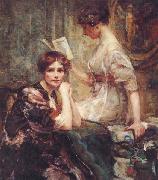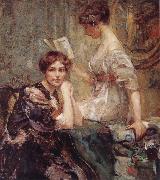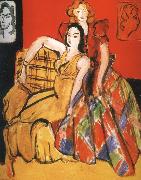Wholesale Oil Painting Reproductions No Minimum and Door to Door! |
|||||||||||
|
|
|||||||||||

|
|||||||||||
|
|
|
||||||||
All Colin Campbell Cooper Oil Paintings |
||||||||
|
|
||||||||
|
|
||||||||
|
Artist Introduction: 1856-1937
Colin
Campbell Cooper Galleries
Cooper was born in Philadelphia, Pennsylvania to Dr. Colin Campbell Cooper and Emily William Cooper. He studied art at the Pennsylvania Academy of the Fine Arts under Thomas Eakins, and at Acad??mie Julian in Paris.
Back in Philadelphia, he taught watercolor classes at the Drexel Institute of Art, Science and Industry (now Drexel University). In 1897 he married renowned artist Emma Lampert, and the next year they moved to New York City, where he began work on his famous skyscraper paintings.
He travelled extensively, sketching and painting scenes of Europe, Asia, and the United States in watercolors and oils. He and his wife were on the RMS Carpathia and assisted in the rescue of the survivors of the Titanic. Several of his paintings document the rescue.
In 1912, Cooper was elected to a prestigious membership in the National Academy of Design.
Cooper exhibited in San Francisco's Panama-Pacific Exposition of 1915, winning the Gold Medal for oil and the Silver Medal for watercolor. He also participated in the Panama-California Exposition in San Diego.
In 1920 his wife Emma died. He moved to Santa Barbara, California in 1921 and became dean of the School of Painting at the Santa Barbara Community School of Arts. He married his second wife, Marie Frehsee, in 1927.
Cooper died in Santa Barbara in 1937. |
||||||||
|
|
||||||||
|
Two Women Painting ID:: 26604 |
mk51
Oil on board
24 1/2x21 1/2inches
|
|||||||
Height Width |
INS/CM Quality |
|||||||
|
X |
| |||||||
|
|
||||||||
All Colin Campbell Cooper Oil Paintings |
||||||||
|
|
||||||||
|
|
||||||||
|
Artist Introduction: 1856-1937
Colin
Campbell Cooper Galleries
Cooper was born in Philadelphia, Pennsylvania to Dr. Colin Campbell Cooper and Emily William Cooper. He studied art at the Pennsylvania Academy of the Fine Arts under Thomas Eakins, and at Acad??mie Julian in Paris.
Back in Philadelphia, he taught watercolor classes at the Drexel Institute of Art, Science and Industry (now Drexel University). In 1897 he married renowned artist Emma Lampert, and the next year they moved to New York City, where he began work on his famous skyscraper paintings.
He travelled extensively, sketching and painting scenes of Europe, Asia, and the United States in watercolors and oils. He and his wife were on the RMS Carpathia and assisted in the rescue of the survivors of the Titanic. Several of his paintings document the rescue.
In 1912, Cooper was elected to a prestigious membership in the National Academy of Design.
Cooper exhibited in San Francisco's Panama-Pacific Exposition of 1915, winning the Gold Medal for oil and the Silver Medal for watercolor. He also participated in the Panama-California Exposition in San Diego.
In 1920 his wife Emma died. He moved to Santa Barbara, California in 1921 and became dean of the School of Painting at the Santa Barbara Community School of Arts. He married his second wife, Marie Frehsee, in 1927.
Cooper died in Santa Barbara in 1937. |
||||||||
|
|
||||||||
|
|
Two Women Painting ID:: 36029 |
kr01
Oil on board
|
||||||
Height Width |
INS/CM Quality |
|||||||
|
X |
| |||||||
|
|
||||||||
All Henri Matisse Oil Paintings |
||||||||
|
|
||||||||
|
|
||||||||
|
Artist Introduction: French Fauvist Painter and Sculptor, 1869-1954
Henri Matisse is considered the most important French artist of the 20th century and, along with Pablo Picasso, one of the most influential modernist painters of the last century. Matisse began studying drawing and painting in the 1890s. A student of the masters of Post-Impressionism, Matisse later made a reputation for himself as the leader of a group of painters known as Les Fauves. An ironic label given to them by a critic, the name reflected Matisse's aggressive strokes and bold use of primary colors. In 1905 Matisse gained sudden fame with three paintings, including Woman with the Hat, purchased by the wealthy American ex-patriot Gertrude Stein. Beyond painting, he worked with lithographs and sculpture, and during World War II he did a series of book designs. Later in his career he experimented with paper cutouts and designed decorations for the Dominican chapel in Vence, France. Along with Picasso, |
||||||||
|
|
||||||||
|
|
Two women Painting ID:: 58055 |
mk260 1941 Oil on canvas years 61 x 50 cm |
||||||
Height Width |
INS/CM Quality |
|||||||
|
X |
| |||||||
|
|
||||||||
|
Prev Next
|
||||||||
|
|
||||||||
|
Related Paintings to Henri Matisse :. |
||||||||
|
|
||||||||
|
CONTACT US |



